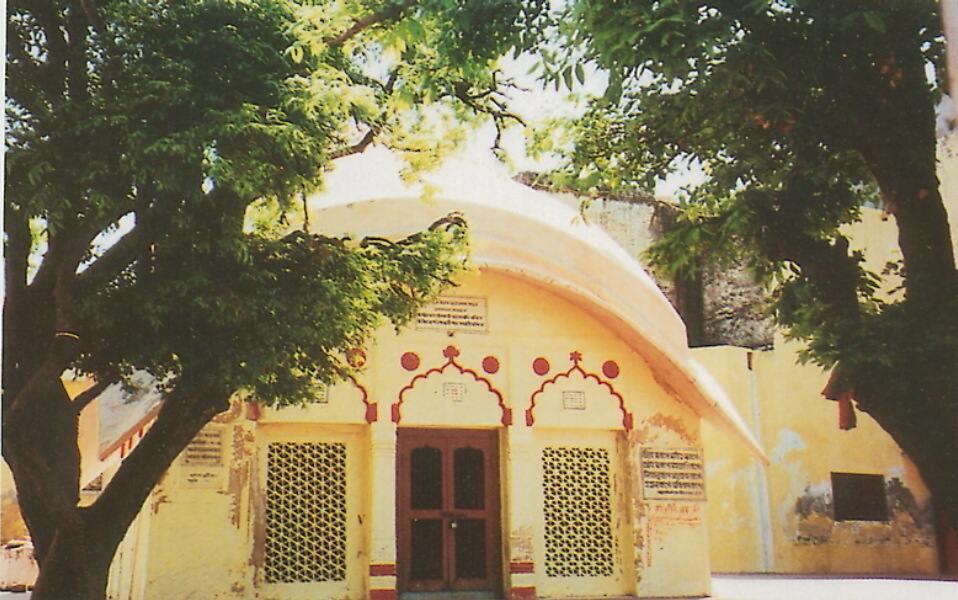
Srila Rupa Goswami Samadhi
1 likes
Vraj Mandal Parikarma – by Rajshekhar Das Brahmacari
Srila Rupa Goswami entered samadhi in the year 1564, and his sacred body was entombed here next to his bhajana kutira, by his beloved disciple and nephew Jiva. Rupa Goswami was born in the year 1489 and first met Lord Chaitanya along with his two brothers at Ramakeli, West Bengal, in 1514, at this first meeting, the three brothers resolved in their hearts to renounce the world and devote their lives to the service of Lord Chaitanya Mahaprabhu. In the year 1516, Rupa Goswami arrived in Vrindavana and spent the rest of his life in propagating the mission of Lord Chaitanya, and by the time he left the world, he had done enough to firmly establish Vrindavana, the place where Lord Krishna performed His transcendental pastimes, as the most important place of pilgrimage, not only in India, but on the entire face of the earth. Even though Rupa Goswami accepted his elder brother Sanatana as his guru, Rupa is recognized as the most prominent amongst the Six Goswamis and was undoubtedly the main driving force in pushing forward Lord Chaitanya’s sankirtana mission. Even though all Gaudiya
Vaishnavas accepted Sanatana Goswami as their guru, being the senior-most disciple of Lord Chaitanya, they simultaneously acknowledged Rupa Goswami as the spiritual leader of all Gaudiya Vaishnavas in the world. In the year 1534, with the sudden disappearance of Lord Chaitanya, it was Shrila Rupa Goswami who kept Lord Chaitanya’s fledgling mission united and steered it to even greater heights, becoming the first great acharya of the newly formed Gaudiya Vaishnava sampradaya founded exclusively on the precepts and teachings of Lord Chaitanya Mahaprabhu.
In the Gaudiya Vaishnava tradition, all the followers of Lord Chaitanya Mahaprabhu are known as Rupanugas, or those who follow in the footsteps of Shrila Rupa Goswami.
According to the Gaura-ganaddesha-dipika, Rupa Goswami was the highly celebrated Rupa-manjari in Krishna’s Vrindavana pastimes. Rupa-manjari is one of Radha’s most confidential maidservants and in the transcendental hierarchy of gopi maidservants; she is considered second only to Lalita-sakhi. It is therefore said in the Vaishnava tantras, that before one can approach Radha and Krishna, one must first approach Lalita-sakhi and take her blessings, then only can one dare to approach Radha and Krishna. Concomitantly, it is also said that before one should approach Lalita, one should first approach her assistant, the all-merciful Rupa-manjari, and take her blessings, then only one can approach Lalita-sakhi.
Vaishnavas accepted Sanatana Goswami as their guru, being the senior-most disciple of Lord Chaitanya, they simultaneously acknowledged Rupa Goswami as the spiritual leader of all Gaudiya Vaishnavas in the world. In the year 1534, with the sudden disappearance of Lord Chaitanya, it was Shrila Rupa Goswami who kept Lord Chaitanya’s fledgling mission united and steered it to even greater heights, becoming the first great acharya of the newly formed Gaudiya Vaishnava sampradaya founded exclusively on the precepts and teachings of Lord Chaitanya Mahaprabhu.
In the Gaudiya Vaishnava tradition, all the followers of Lord Chaitanya Mahaprabhu are known as Rupanugas, or those who follow in the footsteps of Shrila Rupa Goswami.
According to the Gaura-ganaddesha-dipika, Rupa Goswami was the highly celebrated Rupa-manjari in Krishna’s Vrindavana pastimes. Rupa-manjari is one of Radha’s most confidential maidservants and in the transcendental hierarchy of gopi maidservants; she is considered second only to Lalita-sakhi. It is therefore said in the Vaishnava tantras, that before one can approach Radha and Krishna, one must first approach Lalita-sakhi and take her blessings, then only can one dare to approach Radha and Krishna. Concomitantly, it is also said that before one should approach Lalita, one should first approach her assistant, the all-merciful Rupa-manjari, and take her blessings, then only one can approach Lalita-sakhi.
Leave a comment